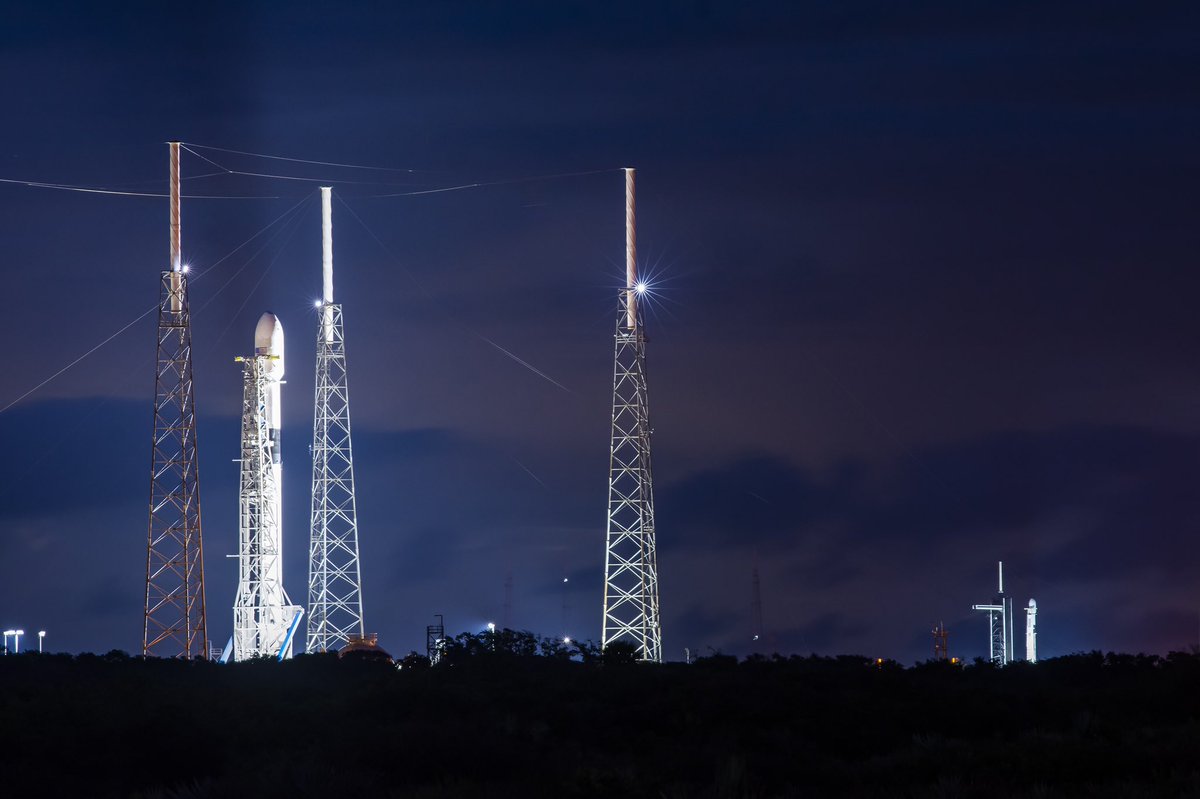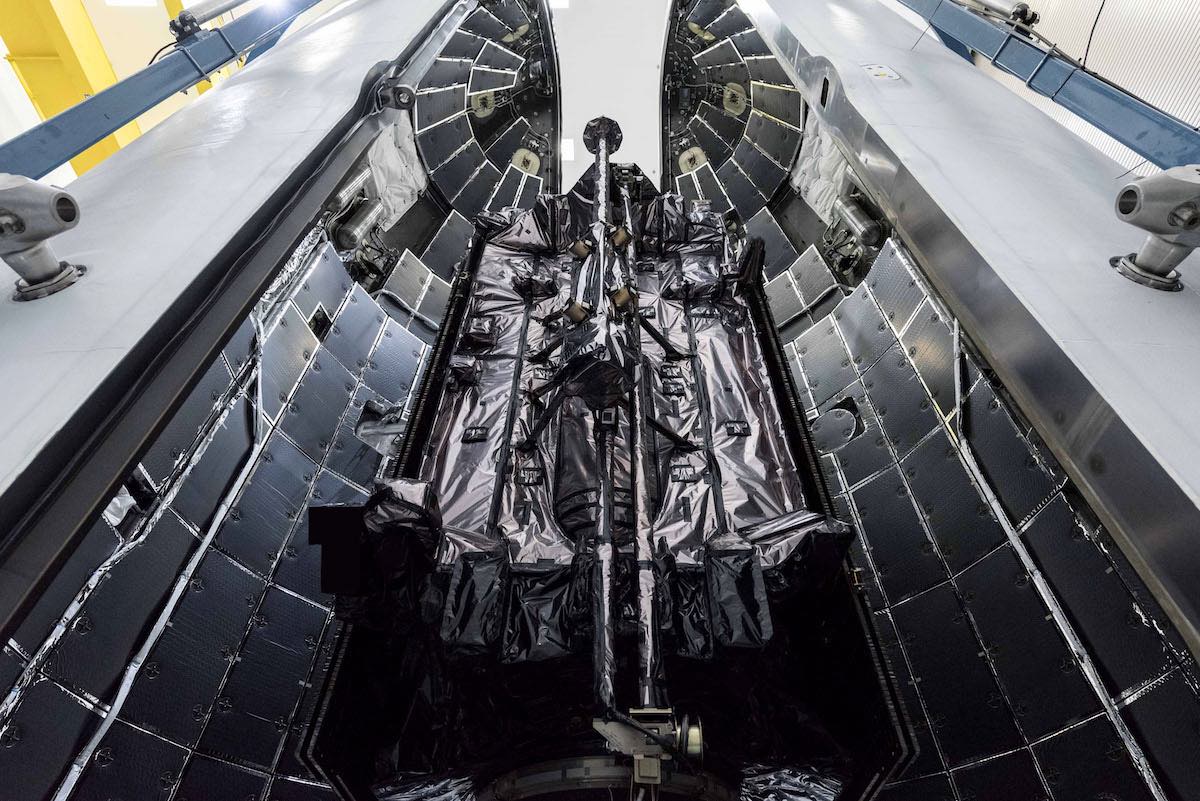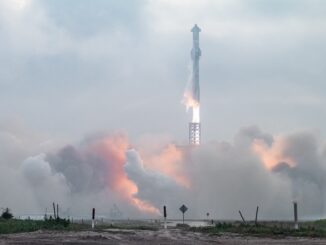
Two SpaceX rockets are standing on launch pads several miles apart on Florida’s Space Coast awaiting launch opportunities Thursday and Friday, once an oft-delayed Delta 4-Heavy rocket from rival United Launch Alliance is able to blast off from Cape Canaveral with a top secret U.S. government spy satellite.
ULA has been trying to launch the Delta 4-Heavy rocket since late August, but a series of problems with the launch pad have kept the heavy-lifter on the ground. The mission will deploy a classified payload into a geosynchronous orbit more than 22,000 miles (nearly 36,000 kilometers) above Earth.
The Delta 4-Heavy flight, with its national security payload likely valued at more than $1 billion, has taken priority on the Space Force’s Eastern Range, which oversees launch scheduling from pads at Cape Canaveral Air Force Station and the neighboring Kennedy Space Center.
A pressure regulator failed at the launch pad during the Delta 4’s ignition sequence Aug. 29, prompting ULA to refurbish and retest equipment before setting up for a launch attempt Saturday, Sept. 26. ULA delayed the mission again to assess an issue with the hydraulic swing arm system at pad 37B, the Delta 4’s launch pad at Cape Canaveral.
Officials kicked off a countdown Monday afternoon for a launch opportunity just after midnight Tuesday. But the threat of lightning prevented ground crews from retracting the launch pad’s towering mobile gantry, which is needed to attach satellites in a vertical configuration on the pad and also provides protection for the rocket before launch.
Storms again delayed rollback of the Mobile Service Tower on Tuesday, but the weather cleared in time to allow technicians to begin moving the gantry. Then a hydraulic leak interrupted the gantry rollback procedure, causing ULA to scrub another launch attempt.
ULA is set to kick off its fifth countdown for the Delta 4-Heavy mission — codenamed NROL-44 — Wednesday afternoon. Clocks will be timed to tick down toward liftoff at 11:54 p.m. EDT Wednesday (0354 GMT Thursday).
Analysts believe the payload aboard the Delta 4-Heavy is a signals intelligence satellite with a giant deployable antenna designed to intercept voice and data traffic from U.S. adversaries.
Several SpaceX missions have been delayed by the Delta 4-Heavy’s ever-changing launch dates. A Falcon 9 launch with Argentina’s SAOCOM 1B radar observation satellite was delayed a month in August due to concerns about the rocket’s flight path near the Delta 4 pad, where the NRO’s high-value payload was sitting on top of the ULA rocket.
The SAOCOM 1B satellite was eventually cleared for flight Aug. 30 after military officials apparently waived their concerns, following the Delta 4-Heavy’s last-minute abort Aug. 29.
A Falcon 9 rocket and a U.S. Space Force Global Positioning System navigation satellite were supposed to go up Tuesday night from pad 40 at Cape Canaveral Air Force Station. But SpaceX has delayed the GPS mission this week in response to the scrubbed Delta 4-Heavy launch attempts.
SpaceX initially rescheduled the GPS launch for Wednesday night after the Delta 4 was delayed to Tuesday. After the Delta 4-Heavy’s scrub Tuesday, SpaceX announced the GPS launch would be pushed back to Friday, when there is a 15-minute launch window available opening at 9:43 p.m. EDT (0143 GMT Saturday).
The Falcon 9 will target an elliptical orbit to release the Lockheed Martin-built GPS 3 SV04 navigation satellite. The spacecraft will then maneuver into a circular orbit 12,550 miles (20,200 kilometers) above Earth to enter the GPS constellation providing worldwide positioning, navigation and timing services.

The launch of SpaceX’s next 60 Starlink broadband satellites has also been impacted by the shuffling schedule at the Cape Canaveral range.
The 60 Starlink satellites are flat-packed on top of a Falcon 9 rocket at pad 39A, located at NASA’s Kennedy Space Center a few miles north of pad 40 and pad 37B. SpaceX tried launching the Starlink mission Monday morning, but scrubbed the countdown less than a minute prior to liftoff due to unfavorable weather.
SpaceX plans to try again to launch the next 60 Starlink satellites Thursday at 9:17 a.m. EDT (1317 GMT). The Falcon 9 rocket will aim to deliver the 60 quarter-ton Internet satellites into a low-altitude orbit on the way to operating orbit 341 miles (550 kilometers) above Earth.
SpaceX has two sea-going landing platforms in the Atlantic Ocean several hundred miles northeast of Cape Canaveral for recovery of the reusable first stage boosters on the GPS and Starlink missions.
The ever-changing launch schedule on Florida’s Space Coast has been dizzying for space enthusiasts, space reporters, and other observers. Michael Ellis, director of SpaceX’s national security space launch division, said last week that it can also be stressful for launch teams.
“These things happen. We’re quite used to the bullwhip effect of new information coming,” Ellis said in a conference call with reporters Friday. “We’re able to handle it because we have such a strong partnership (with the range), and the communication is transparent.
“I’d be lying if I were to tell you that it isn’t sometimes stressful, but up to this point, we have two pads. We have teams dedicated to support simultaneous operations and we’re able to, with our partnership, work hand-in-hand with the Space Force.”
Brig. Gen. Doug Schiess, commander of the 45th Space Wing that oversees range operations at Cape Canaveral, said Friday that the range has improved its ability to handle the quickening pace of launches.
“I’ve been in the launch business for quite a while, and a lot of it was keeping things to ourselves,” Schiess said. “Recently, we’ve done a lot of work where we’re all in the same room together — ULA, SpaceX, and eventually others as they come to the Eastern Range — and we try to work through the schedule.”
The introduction of autonomous flight safety systems has helped range safety officials shorten the time needed between launches. The autonomous safety systems allow rockets to automatically terminate their flights if they fly off course, replacing destruct systems that rely on a manual command from a range safety officer.
SpaceX’s Falcon 9 rockets use autonomous safety systems. ULA’s Atlas 5 and Delta 4 rockets still use the older flight termination system design, but will transition to an automated design with the next-generation Vulcan Centaur rocket.
Because the military deems the NROL-44 payload of critical importance, the 45th Space Wing gives the Delta 4-Heavy three launch opportunities at a time. Most missions receive just two dates — a primary and backup opportunity — before having to submit a new request to the range.
“Because the Delta 4 had one launch date with two backups because of its importance, in the past we would not have given SpaceX the opportunity to launch (on one of the backup dates),” Schiess said.
Now the range gives SpaceX an opportunity to secure a date on a Delta 4 backup date. The launch opportunity is then contingent upon the Delta 4 actually launching, or at least delaying long enough to clear out of the way.
“I think that’s part of that collaboration, with the caveat that, ‘Hey, you can have this (date), but if this doesn’t go, we’re going to have to do something else,” Schiess said. “In the past we would not have done that. We would have said those three days are for Delta 4-Heavy, and you’re going to have to wait. So I think that’s part of that collaboration that we’re really trying to work to be able to get as many opportunities as possible.”
Ellis said SpaceX also prioritizes national security missions, such as the GPS launch, on its internal manifest when deciding when to find slots for the company’s own Starlink launches.
Email the author.
Follow Stephen Clark on Twitter: @StephenClark1.



